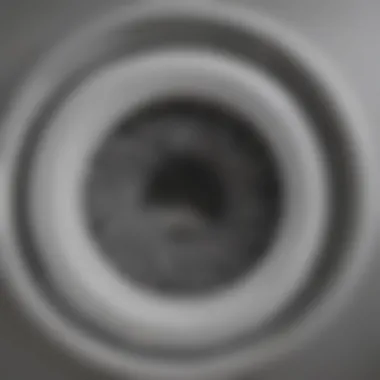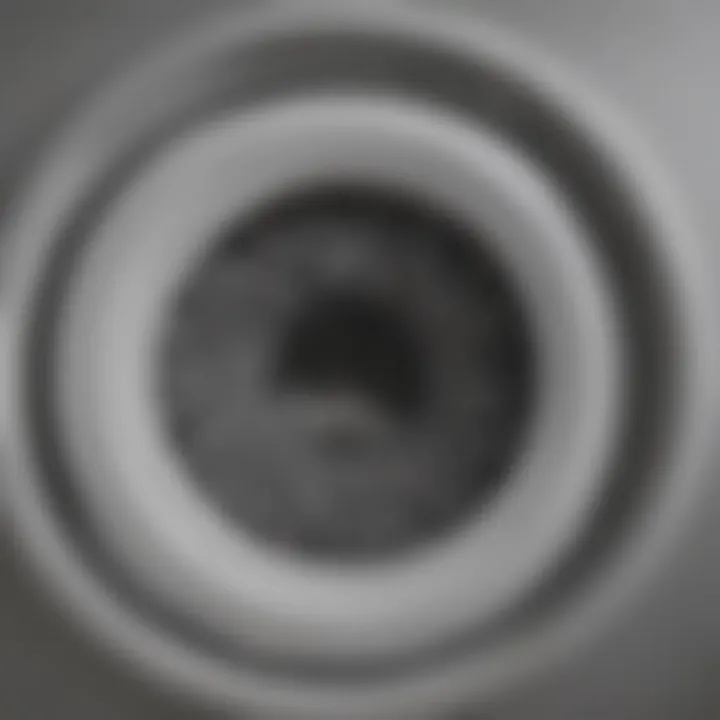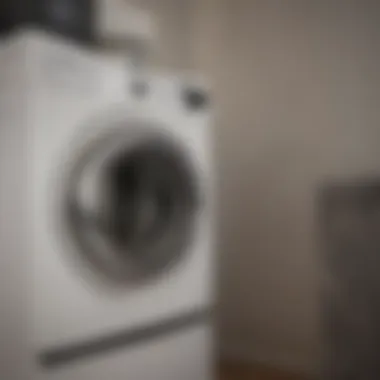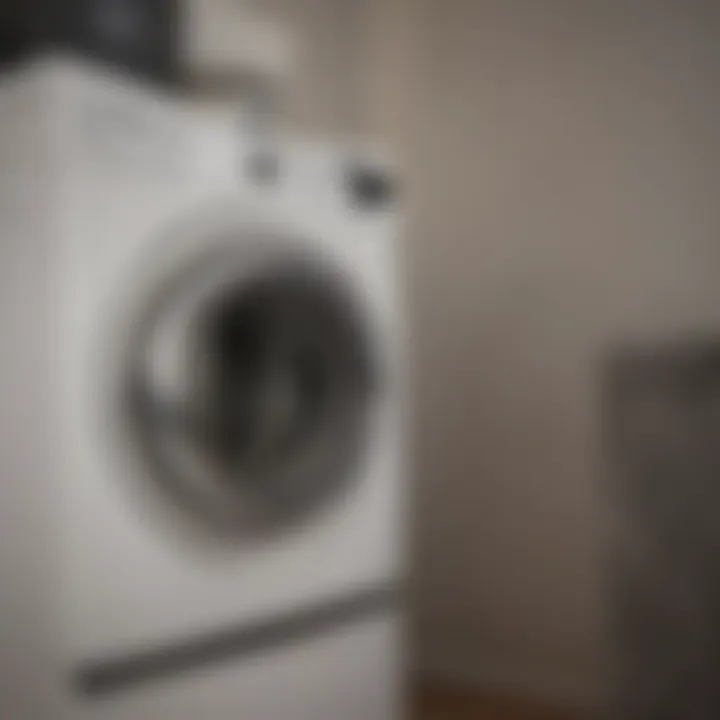Essential Guide to Dryer Vent Cleaning Frequency


Intro
Keeping a home safe and efficient is important for every homeowner. One of the often-neglected aspects of home maintenance is the dryer vent. Understanding how frequently to clean this component can significantly impact both safety and efficiency. Lint buildup in dryer vents can lead to dangerous situations, such as house fires. It can also hinder your appliance's performance, making it work harder than necessary and increasing energy bills.
This article aims to provide clarity on the recommended frequency for dryer vent cleaning. We will explore factors that influence maintenance schedules, such as usage and household factors. The upcoming sections will also identify signs indicating it might be time for a cleaning, provide practical tips for homeowners, and emphasize the importance of professional services.
A comprehensive grasp of these elements can empower homeowners to maintain their appliances effectively. This ensures not only their longevity but also the safety of the household.
Featured Homes
Dryer vent cleaning is an essential part of maintenance in various types of homes. From modern apartments to historic residences, understanding airflow can often be overlooked, leading to unnecessary risks. In featured homes, specific architectural highlights may create unique challenges in dryer vent functionality.
- Architectural Highlights: Some older homes have narrower vent systems that are more prone to lint buildup, while newer constructions may benefit from enhanced designs that promote better airflow. Recognizing these differences can help homeowners create informed cleaning schedules that suit their homes.
- Interior Design Themes: A well-designed laundry space encourages routine checks of your dryer vent. Incorporating functional yet stylish design elements can emphasize the importance of maintaining appliances hidden behind elegant cabinetry or concealed behind decorative screens.
Understanding Frequency
The frequency with which a homeowner should clean their dryer vent is influenced by various factors:
- Dryer Usage: Frequent use of a laundry dryer results in more lint accumulation. If the dryer is used daily, cleaning every six months is often advisable. For lighter usage, once a year may suffice.
- Household Factors: Large families or homes where multiple loads are done weekly will require more vigilance than smaller households.
- Lint Buildup: If clothes are consistently taking longer to dry, it might indicate a blocked vent, triggering the need for immediate cleaning.
Signs of Needed Cleaning
Homeowners should be vigilant for signs that indicate their dryer vent requires attention.
- Clothes take longer to dry
- A burning smell when it’s in use
- Increased humidity in the laundry area
- The vent hood flap does not open properly when the dryer is on
"Acknowledging these signals can prevent serious situations before they arise. Don't wait for a malfunction. Regular maintenance is crucial."
Professional Services
While homeowners can manage routine cleaning, professional services provide specialized expertise that might be necessary for thorough cleaning. Technicians from companies like Dryer Vent Wizard can assess tricky situations, ensuring that vents are free of lint and properly installed. Their equipment can handle cleaning deeper into the vent system and potentially identify underlying issues unnoticed by the average homeowner.
Preamble to Dryer Vent Cleaning
Importance of Dryer Vent Maintenance
Regular dryer vent maintenance has multiple benefits. Firstly, it decreases the risk of fire hazards. According to the U.S. Fire Administration, nearly 3,000 dryer fires occur each year, largely due to flammable lint buildup. Keeping the dryer vents clean significantly lowers this risk. Secondly, regular cleaning can improve the dryer’s efficiency. When vents are clogged, dryers have to work harder and longer to dry clothes, leading to increased energy consumption. This not only raises utility bills but can contribute to wear and tear on the appliance itself, ultimately shortening its lifespan.
Frequent maintenance also ensures better air quality inside the home. When lint accumulates in the vent, it can circulate through the air in your living spaces. This can be particularly detrimental for individuals with allergies or respiratory issues. Therefore, ensuring that dryer vents are cleaned regularly benefits not just the appliance, but also the inhabitants of the home.
Overview of Lint Buildup and Fire Hazards
Lint buildup is an inevitable byproduct of using a dryer. Every time clothes are dried, tiny fibers are released into the airflow, eventually making their way into the venting system. If not addressed, this buildup can accumulate to a dangerous extent. The dry and flammable nature of lint significantly raises the fire risk, especially when combined with heat generated during the drying process.
A clear path for airflow is crucial for safe dryer operation. If lint accumulates and blocks the vent, the dryer cannot expel hot air effectively. This not only causes clothes to dry inefficiently but also increases the heat within the appliance, leading to a higher chance of ignition. Taking preventative measures against lint buildup is essential for maintaining a safe drying environment. Furthermore, periodic inspection of the vent can help identify any warning signs of excessive accumulation before they escalate into serious hazards.
"The risk of dryer fires can be mitigated significantly with regular cleaning and maintenance of dryer vents."
This highlights the fundamental importance of understanding when and how to effectively clean dryer vents.
Recommended Cleaning Frequency
General Guidelines for Cleaning Intervals
General recommendations suggest that dryer vents should be cleaned at least once a year. However, this can vary based on several factors like the frequency of use and household size. For example, households that do multiple loads of laundry each week may need to perform cleaning more frequently—potentially every six months. Here are some guidelines to follow:
- Average Use: Once per year.
- Heavy Use: Every six months.
- Light Use: Once every two years.
Establishing a routine not only helps with machine performance but also keeps safety as a priority. It is important to calibrate your cleaning schedule based on your specific household circumstances.


Usage Patterns and Their Impact
The way a dryer is used can significantly influence how often it needs cleaning. Frequent use leads to more lint accumulation. Families with children or those who regularly host guests often have increased laundry loads. Assessing your laundry habits can help you tailor your cleaning routine.
Consider the following:
- Large Families: With several members can lead to more laundry, increasing lint buildup. Cleaning may be required every six months.
- Small Households: A couple or single person may not need to clean as often, potentially stretching intervals to yearly.
It's also worth noting different materials. For example, towels and blankets produce more lint compared to lighter fabrics. If your laundry loads primarily consist of high-lint items, a more frequent cleaning schedule is advisable.
Variations by Dryer Type
Different types of dryers come with distinct requirements for maintenance. Traditional vented dryers typically require more frequent vent cleaning when compared to ventless models. This is due to the nature of how air and lint are expelled with each load.
- Vented Dryers: Usually, these models benefit from more considerable airflow. Their vents can accumulate lint faster, suggesting a routine clean every six months to one year.
- Ventless Dryers: Since they recirculate air, they do not produce as much lint buildup. Cleaning may only be necessary once a year or even less frequently.
Understanding your dryer type helps in developing a relevant cleaning strategy that aligns with its unique characteristics. Regular assessments will improve your dryer’s performance and overall home safety.
Factors Influencing Cleaning Frequency
The frequency with which a dryer vent should be cleaned hinges on various nuances within each home. Understanding these influencing factors not only enhances the effectiveness of dryer operations but also significantly mitigates fire hazards associated with poor vent maintenance. A deeper dive into house sizes, usage patterns, load types, and the characteristics of ventilation systems reveals key considerations that can define when and how often a cleaning is necessary.
Household Size and Dryer Use
Household dynamics play a pivotal role in determining the cleaning frequency of dryer vents. A larger family typically generates more laundry, leading to increased dryer use. As a result, lint accumulates quicker. It is advisable that families with four or more members should consider having their dryer vents cleaned at least once a year. In contrast, smaller households may manage with cleaning every 18 months or so, depending on their frequency of laundry loads.
Moreover, the tendencies of those using the dryer matter as well. If multiple individuals use the dryer throughout the week, a more rigorous schedule may be warranted. One must also be mindful of the cycles run, as heavier or larger loads can produce more lint than delicate loads.
Type of Laundry Loads
Not all laundry loads are created equal; the materials involved significantly affect lint production. For instance, washing heavy towels, blankets, or cotton fabrics tends to produce much more lint compared to lighter synthetic fabrics. Thus, households that often wash such items should consider increasing the cleaning frequency for their dryer vents.
Specific fabrics like fleece or microfiber are notorious for releasing a considerable amount of lint. If these materials are standard in the household's laundry routine, it becomes imperative to be vigilant about accumulated lint in the vent. Regular inspection can prevent exacerbation of any potential hazards.
Ventilation System Considerations
The configuration of a home's ventilation system can heavily influence cleaning frequency. Some dryers are vented to exterior walls, which is preferable as it allows for efficient airflow. However, if the vent system runs longer distances or has bends, lint may accumulate more rapidly.
Therefore, a longer vent may necessitate frequent checks and cleanings. Homeowners must ensure that the vent pipe is as straight as possible to allow for optimal air circulation. Regular evaluations can identify restrictions or pinch points that may trap lint, thereby affecting overall performance and safety as well.
Efficient airflow is crucial for dryer safety. A compromised ventilation system can hinder dryer function, increasing the likelihood of accidents.
Signs Indicating a Need for Cleaning
Recognizing the signs that indicate it’s time to clean the dryer vent is critical for maintaining safety and efficiency in any home. Overlooking these indications can lead to reduced appliance performance and even hazardous situations. Therefore, knowing what to watch for can help homeowners take proactive steps to avoid larger problems down the line.
Longer Drying Times
One of the first signs that a dryer vent may require cleaning is an increase in drying times. If clothes are taking longer than usual to dry, it could indicate that lint buildup is obstructing the airflow. The dryer works harder to push air through the vent, leading to more energy consumption and wear on the machine. Homeowners should monitor their dryer performance closely. If they notice that even lighter fabrics do not dry adequately, it’s time to check the vent.
Burning Smell During Use
Another concerning sign is a burning smell that may occur while the dryer is operating. This odor often suggests overheating due to restricted airflow caused by lint accumulation. Lint traps can capture a significant amount of lint, but some may escape into the vent system. If a burning smell is detected, it signifies that the lint buildup could create a risk of a fire hazard. It is imperative to turn off the dryer immediately and inspect the venting system to prevent potential damage and ensure safety.
Excessive Lint Accumulation
Excessive lint accumulation around the lint trap or within the vent is a clear indicator that a cleaning is overdue. During routine usage, a certain amount of lint is expected, but if homeowners find that lint builds up to an alarming level after every cycle, it raises a red flag about vent performance. Regular visual evaluations of the lint trap and vent system can provide useful insights into the overall condition. If the lint is thick and clumpy, it may require immediate attention to avert serious issues.
Maintaining vigilance regarding these signs is crucial for ensuring that the dryer functions effectively and safely.


By staying aware of symptoms like longer drying times, a burning smell, and excessive lint accumulation, homeowners can enact timely cleaning and maintenance. This diligence not only supports appliance longevity but also enhances household safety.
DIY Dryer Vent Cleaning Techniques
Cleaning your dryer vent is critical for two main reasons: safety and efficiency. When lint accumulates in the vent, it becomes a fire hazard. Lint is highly flammable, and extended use of a blocked vent can easily lead to a situation that may cause a fire. Besides safety concerns, a clean dryer vent also means your dryer works more effectively, reducing drying times and saving energy.
Taking the DIY approach to dryer vent cleaning is beneficial for homeowners. It not only saves money on hiring professionals but also equips you with knowledge to maintain your appliance better. However, being aware of the required tools and processes is key to effective cleaning.
Essential Tools for Cleaning
To carry out a thorough cleaning, having the right tools is essential. Here’s a list of some necessary tools that you should collect before starting:
- Vacuum with Hose Attachment: A powerful vacuum can reach deep into the vent and remove accumulated lint effectively.
- Dryer Vent Brush: This specific tool is designed to sweep away lint that vacuum may miss. Its flexible design allows it to reach bends in the vent.
- Screwdriver: You may need this to detach the vent from the dryer or the wall.
- Duct Tape: Useful for securing any loose connections after cleaning.
- Safety Goggles: Protect your eyes from lint and dust.
Having these tools on hand makes the process smoother and more efficient.
Step-by-Step Cleaning Process
Cleaning your dryer vent does not have to be overwhelming. Here’s a simplified process that you can follow to get the job done:
- Disconnect the Dryer: Safety first. Unplug the dryer from the power source before you begin.
- Remove the Vent Hose: Use your screwdriver to detach the duct from both the dryer and the wall outlet.
- Inspect the Vent: Look for any visible lint buildup. Use your vacuum to remove any loose debris within reach.
- Use the Dryer Vent Brush: Insert the brush into the duct and rotate it to dislodge lint. Pull the brush out periodically to remove the collected lint.
- Vacuum Again: After brushing, vacuum the vent thoroughly to catch any remaining lint.
- Clean the Outside Vent: Go outside and check the vent cap. Remove any buildup or blockages.
- Reattach Everything: Once you are done cleaning, carefully reconnect the vent hose with duct tape to ensure a tight seal.
- Test the Dryer: Plug the dryer back in, and run it for a few minutes to ensure that air flows freely.
"Regular maintenance of your dryer vent can extend the life of your appliance and significantly lower the risk of fire hazards."
By following these steps, you will significantly enhance the performance of your dryer and ensure a safer environment. Implementing these DIY techniques should form part of your routine home maintenance.
Professional Dryer Vent Cleaning Services
The significance of professional dryer vent cleaning services can not be overstated. These services ensure that the dryer operates efficiently while minimizing safety hazards at the same time. While some homeowners may see dryer vent cleaning as simply another household chore, the truth is that neglecting this duty can lead to severe repercussions, including increased energy costs and fire risks.
By employing professionals, homeowners gain access to specialized tools and techniques that most individuals lack. This not only improves cleaning efficiency but also guarantees both thorough cleaning and maintenance checks that might be overlooked during a DIY effort. The key elements to consider when contemplating professional service include the thoroughness of the cleaning, the expertise of the technicians, and the overall benefits that come with hiring professionals.
When to Seek Professional Help
There are specific scenarios where seeking professional help for dryer vent cleaning becomes paramount:
- Persistent Issues: If a dryer shows signs of poor performance, even after regular cleaning, it may indicate a deeper problem within the venting system.
- Long Intervals since Last Cleaning: Homeowners should consider professional cleaning services if it has been more than a year since their last vent cleaning.
- Visible Blockages: If lint or debris is visibly building up around the vent, professionals can diagnose and address the blockage properly.
- Recent Home Purchase: New homeowners often benefit from a professional inspection to assess the condition of the dryer vents, especially if they are uncertain about the maintenance history.
In these instances, professional intervention is not just recommended; it is essential to maintaining both safety and appliance efficiency.
Evaluating Service Providers
Choosing a professional dryer vent cleaning service requires careful evaluation to ensure that homeowners receive the best quality service. A few key points to consider include:
- Reputation and Reviews: Researching online reviews and asking for recommendations from friends and family can lead to finding reliable service providers. Resources like reddit.com can give insights from actual users about their experiences.
- Certifications and Training: Check if the cleaning service employs certified technicians who are trained in current techniques and best practices for vent cleaning.
- Insurance Coverage: A reputable provider should have appropriate insurance. This protects homeowners from liability in case of accidents during the cleaning process.
- Cost Estimates: Obtain multiple estimates to ensure that the pricing is transparent and fair. Significant differences in quotes can indicate varying levels of service.
"Investing in professional services not only extends the lifespan of your dryer but also significantly reduces the risk of fire hazards due to lint buildup."
Evaluating providers on these criteria can lead to informed decisions that safeguard both the home and its occupants.
Costs Associated with Dryer Vent Cleaning
Understanding the costs associated with dryer vent cleaning is crucial for homeowners and property managers alike. These costs not only reflect the financial implications of maintenance but also the long-term benefits of safety and efficiency. Lint buildup in dryer vents can lead to increased drying times and even fire hazards. Thus, investing in regular cleaning can prevent more significant expenses related to repairs or replacements.
DIY vs. Professional Costs
When it comes to cleaning dryer vents, homeowners typically face two primary options: do it themselves or hire a professional service. Each option has its distinct cost implications.
DIY Cleaning:
This approach might seem less expensive at first sight. Costs generally include necessary tools, such as a vent cleaning brush, a vacuum, and possibly ladders if the vent is high up. The total outlay can range between $30 to $100, based on the quality of the tools purchased. However, one must consider factors like the required knowledge and time commitment.


Professional Services:
Hiring a professional can be seen as more costly initially, with prices often ranging from $100 to $250. Yet, these services typically come with the expertise to ensure a thorough cleaning. Professionals can identify issues that may go unnoticed during a DIY job. As a result, they can offer insights on any repairs needed, which can protect homeowners from future costs.
In summary, opting for DIY might save money upfront, but professional help can lead to better long-term savings by preventing larger maintenance issues.
Factors Affecting Overall Price
A variety of factors influence the overall cost of dryer vent cleaning. It's essential to recognize these elements when planning for or considering a cleaning service.
- Location:
- Vent Length and Complexity:
- Extent of Lint Buildup:
- Accessibility:
- Prices can vary significantly based on geographic area. Urban centers often have higher labor costs than rural areas.
- Longer or more complex vent systems may require more time and effort to clean. Costs can increase with the added complexity of navigating bends and turns in the vent.
- Heavily clogged vents may require additional services, such as a thorough vacuuming or even an inspection. This can lead to higher overall costs due to extra labor.
- If the dryer vent is hard to reach, such as those requiring special tools or techniques, this can also increase labor time and, consequently, the price.
"Investing in dryer vent cleaning is not just a cost; it’s a safeguard against future expenses due to fire hazards and decreased efficiency."
- Service Packages:
- Some companies offer maintenance packages that provide discounts for routine cleanings. This can help in budgeting and ensuring another layer of protection.
By weighing these factors, homeowners can better prepare for the financial aspects of dryer vent cleaning while also recognizing the value of this essential maintenance.
Dryer Vent Maintenance Tips
Maintaining dryer vents is crucial for safety and efficiency in your laundry process. A clean dryer vent allows for effective airflow, reducing the risk of fire hazards associated with lint buildup. Moreover, timely maintenance extends the lifespan of your dryer and can decrease energy bills, as the appliance does not have to work harder to expel moisture from clothes.
Establishing regular vent maintenance practices can mitigate rapid accumulation of lint and ensure that the dryer operates under optimal conditions. This is especially important in households with high laundry loads or specific types of fabrics that shed more lint. By implementing consistent maintenance, homeowners can significantly improve the functionality of their dryers while prioritizing safety.
Creating a Maintenance Schedule
A maintenance schedule is an essential tool for ensuring that your dryer vents are cleaned regularly. The frequency of cleaning should consider several factors, including the size of your household and how often the dryer is used. One useful approach is to develop a simple calendar that denotes cleaning intervals.
Here are some guidelines for establishing a dryer vent cleaning schedule:
- For small households (one or two people): At least twice a year.
- For medium households (three to five people): Every three to four months.
- For large households (six or more people): Monthly cleaning may be necessary.
To enhance this schedule, consider adding reminders or specific dates to ensure it doesn’t get overlooked. This method provides a structured approach, which can contribute greatly to maintaining dryer efficiency.
Best Practices for Use
In addition to a cleaning schedule, practicing proper usage techniques can promote better dryer performance and safety. Here are several best practices to follow:
- Avoid Overloading the Dryer
Overloading can restrict airflow, causing lint to accumulate more quickly. It's advisable to dry smaller loads while allowing adequate space for items to tumble freely. - Use a Lint Screen
Clean the lint screen after every load. This captures a significant amount of lint before it enters the vent system. - Limit Drying Time
Take care not to run the dryer longer than necessary. Use the moisture sensor feature if available, as it detects when clothes are dry and stops the cycle. - Check Venting Systems
Inspect the venting system for any obstructions or damage. Ensure ductwork is straight and uses minimal bends, allowing for clear airflow.
By following these best practices, homeowners can create a safer and more efficient environment for their laundry processes. Regular attention to dryer vent maintenance leads to a more effective appliance that saves energy and reduces risk.
The End
The conclusion serves as a pivotal part of this article, summarizing the essential insights regarding the frequency of dryer vent cleaning. Understanding these insights enhances not just appliance safety but also home efficiency.
Regular dryer vent maintenance is crucial for preventing fire hazards and ensuring optimal performance. Neglecting this task can lead to significant lint buildup, which can increase drying times and escalate energy costs. It is essential to create a routine that aligns with individual usage patterns and household dynamics. Each homeowner should acknowledge the factors influencing the frequency of cleaning, such as the size of the household and the type of laundry loads.
Summary of Key Points
- Importance of Maintenance: Regular cleaning prevents fire hazards associated with lint accumulation.
- Recommended Frequency: Guidelines suggest cleaning based on varying factors, including the frequency of dryer use and household size.
- Signs for Cleaning: Homeowners should monitor their dryer performance for signs like longer drying times or burning smells, which indicate a need for immediate attention.
- DIY vs. Professional Services: Both DIY methods and professional cleaning services can be effective, depending on the homeowner's skill level and comfort with such tasks.
Final Recommendations
For those who seek to maintain a safe and efficient laundry environment, the following recommendations are vital:
- Create a Maintenance Schedule: Set reminders for regular cleaning intervals, typically every six months to one year.
- Monitor Usage: Be aware of how often the dryer is used. High usage may necessitate more frequent cleanings.
- Inspect Regularly: Check the vent and ducts for any signs of lint buildup or blockages.
- Consider Professional Help: If unsure about cleaning tasks, hiring a professional service can offer peace of mind.
Implementing these recommendations not only helps in maintaining safety standards but contributes to the longevity and efficiency of home appliances. By embracing a proactive approach to dryer vent cleaning, homeowners can assure both functionality and safety in their households. > The key to safety and efficiency in home appliance maintenance is consistency in care and awareness of usage patterns.







